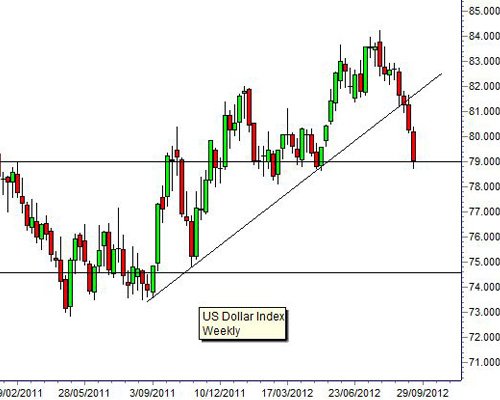That’s exactly what many well-respected economists, billionaires, and noted authors are telling you to do — experts such as Marc Faber, Peter Schiff, Donald Trump, and Robert Wiedemer. According to them, we are on the verge of another recession, and this one will be far worse than what we experienced during the last financial crisis.
Marc Faber, the noted Swiss economist and investor, has voiced his concerns for the U.S. economy numerous times during recent media appearances, stating, “I think somewhere down the line we will have a massive wealth destruction. I would say that well-to-do people may lose up to 50 percent of their total wealth.”
When he was asked what sort of odds he put on a global recession happening, the economist famous for his ominous predictions quickly answered . . . “100 percent.”
Faber points out that this bleak outlook stems directly from Federal Reserve Chairman Ben Bernanke’s policy decisions, and the continuous printing of new money, referred to as “quantitative easing” in the media.
Dollar Falls Most Since 2011 as Central Banks Bump Up Stimulus
The Dollar Index fell by the most since the first quarter of 2011 after the European Central Bank pledged to protect the euro from unraveling and the Federal Reserve committed to reduce unemployment via open-ended debt buying, which may debase the U.S. currency.
Since July 26, when ECB President Mario Draghi said he would do “whatever it takes” to save the euro, the 17-nation currency rose versus 15 of its 16 most-traded counterparts tracked by Bloomberg. Amid the Fed’s expansion of monetary stimulus, the Dollar Index lost 2.1 percent in the third quarter. The Bank of Japan, which followed the Fed and the ECB in expanding its balance sheet by 10 trillion yen ($130 billion), is scheduled to announce its next policy decision on Oct. 5.
CNBC: Dollar Index Headed for Rapid Collapse” Over Next 3 to 4 Weeks
Quantitative easing is really another word for currency wars. A weak U.S. currency puts continued pressure on the Japanese Yen, the Chinese Yuan, the South Korean Won, the Australian dollar and other currencies.
Cheap money also fuels speculation and this money quickly drifts into commodity markets and the ETFs that help propel commodity market speculation. This is inflationary for food prices.
The lower the U.S. dollar the greater the intensity of currency wars.The break below the key uptrend line on the Dollar Index chart was an early warning of the third round of quantitative easing (QE3).

The most important question now is to use the chart to examine the potential downside limits of a QE3 weakened U.S. dollar.
The weekly close below this uptrend line was the first signal of a major change in the trend direction. It came before the announcement of QE3, last week.
The third significant feature is historical support near 74.5. This is the upper edge of a consolidation band between 73.5 and 74.5. This is the downside target for the Dollar Index following a fall below 79.
This target can be reached very rapidly over three to four weeks. A rapid collapse of the U.S. dollar puts immediate pressure on other dollar-linked currencies.
There is a very low probability the U.S. dollar will resume its uptrend. The move below the value of the uptrend line and a fall below 79 confirm thata new downtrend has developed.
The weakness in the U.S. Dollar will hurt export dependent economies and companies.
CNBC
Why The Fed Can’t Stop Printing? NIALL FERGUSON: US UNFUNDED LIABILITIES TOP $238 TRILLION!!
Somehow we missed this over the summer.
In an excellent economic lecture series presented by the BBC, economic historian (& author of the recent Newsweek piece Hit the Road Barack) Niall Ferguson states that the total US unfunded liabilities is a mind-blowing $238 TRILLION- over 16 times the total US debt claimed by the Treasury Department of $16 trillion!!
Can you say QE to INFINITY….AND BEYOND!!! ? There is simply no other viable solution.Ferguson’s full lectures can be downloaded here:
The rapidly rising quantity of these bonds certainly implies a growing charge on those in employment, now and in the future, since – even if the current low rates of interest enjoyed by the biggest sovereign borrowers persist – the amount of money needed to service the debt must inexorably rise.
But the official debts in the form of bonds do not include the often far larger unfunded liabilities of welfare schemes like – to give the biggest American schemes – Medicare, Medicaid and Social Security.
The most recent estimate for the difference between the net present value of federal government liabilities and the net present value of future federal revenues is $200 trillion, nearly thirteen times the debt as stated by the U.S. Treasury.
Notice that these figures, too, are incomplete, since they omit the unfunded liabilities of state and local governments, which are estimated to be around $38 trillion.
Zerohedge: Can The Fed Ever Exit?
ALARMING! Washington’s Dilemma! Soaring debt and a budget Congress can’t balance
This VIDEO explains WHY. Every person in AMERICA should watch this video! Over 3.1 million VIEWS!
Read more at http://investmentwatchblog.com/high-alert-a-massive-wealth-destruction-is-coming-as-paper-u-s-currency-is-rapidly-becoming-worthless-and-people-may-lose-up-to-50-percent-of-their-total-wealth/#Y78iEJFBJKoxrgf2.99
No comments:
Post a Comment